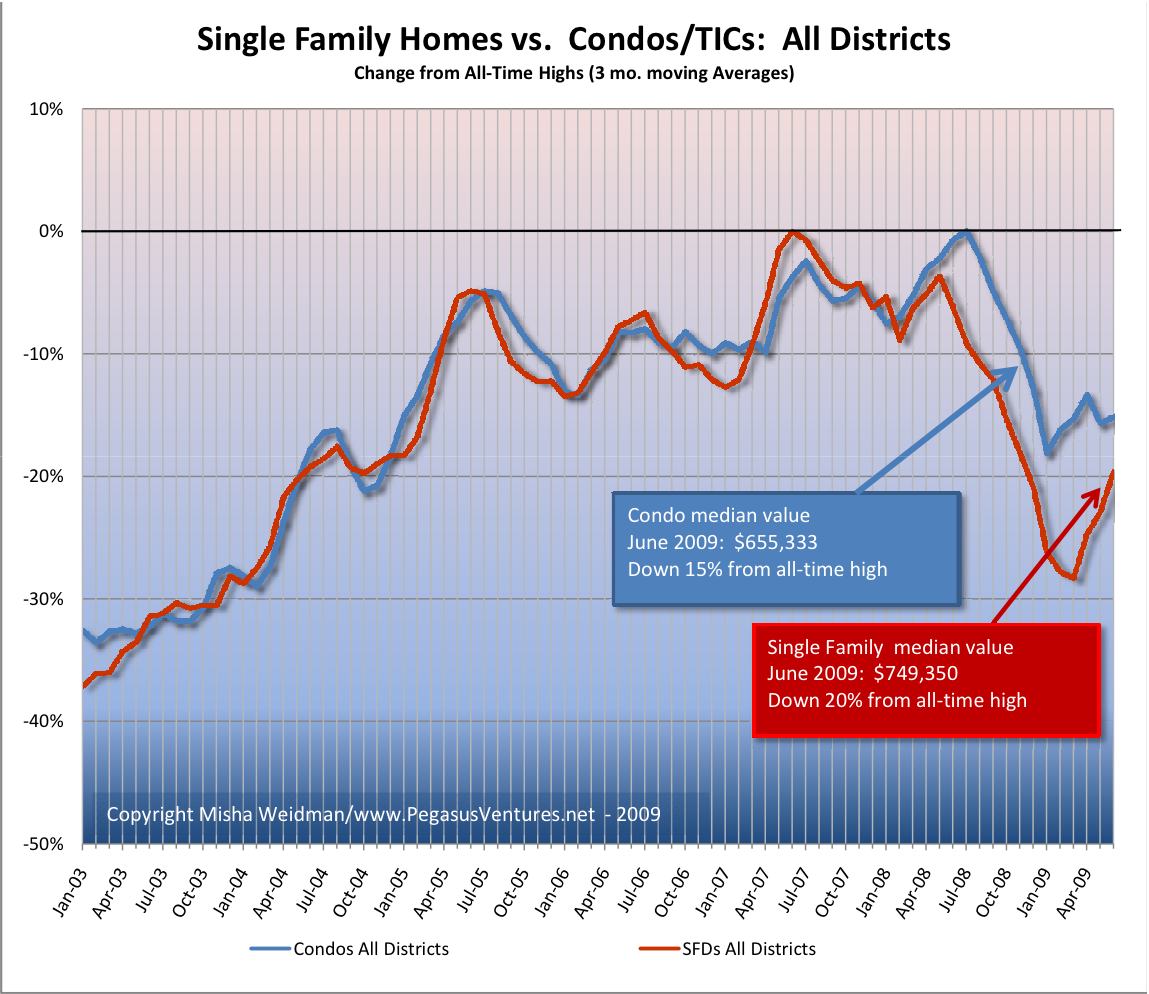For the quarter century (gulp!) that I’ve been involved in real estate, the conventional wisdom has always been that condo values generally do worse in down markets than homes. Why? To be honest, I’m not sure, but I think it’s because it’s easier to overbuild the condo market than the single family home market. It goes back to that famous quote: “Buy land – they aren’t making any more of it.” Just take a look at Miami, Chicago – or downtown San Francisco. One new high-rise can hold hundreds of condos in the sky. Try building just one new home in SF, let alone hundreds – it aint happening.Of course, more supply + less demand in a down market means prices fall. Has that been the case in San Francisco?
I looked at percentage change from all time highs for condos and single family homes (sfd’s) since January 2003 and here are the results for the city as a whole.
Until June 2008, condo and home prices were in lock-step in terms of price appreciation and decline. Thereafter, homes fell first and further. (Do I hear a lithp?) In March 2009, the delta between condos and home prices was a whopping 13%. Since then, however, home prices have recovered smartly: as of June, homes are about 4.5% further off their all-time highs than condos.
What does this all mean? First of all, I wouldn’t take too much consolation just yet in the upward spike in both condo and home prices since the beginning of the year. If you take a look at the chart, this happens every Jan/Feb when people start buying out of the winter doldrums. I wouldn’t predict a bottom until we see what happens this winter.
Secondly, given the woeful condition of the economy and the credit markets, together with the fact that San Francisco is not a badly overbuilt housing market, it sort of makes sense that condos are holding their value relatively well as people are finding themselves priced out of more expensive single family homes.
Still, the current delta of only $100,000 between median condo and median home prices seems rather small. If people are just begging to know what the historical average is, let me know and I’ll find out.


I don’t think that your inference is correct. You are saying that the price for a given condo has held up better versus the price for a given SFH but you make a common error of ignoring the mix of homes that make up the median. You simply cannot compare the medians of two data sets in this way and form a statistically valid conclusion.
What I suspect is that a ton of SFHs (perhaps from Bayview?) have been skewing the SFH mix for some time now. To truly validate your conclusion, you’d have to use datasets from Case/Shiller or OFHEO, which compare repeat sales of the same property… Sorry.
Dave: thanks for the comment, but I don’t think you’ve correctly characterized my inference. I am not comparing a given condo to a given home, though I agree that in some ways that my be the best measure of the market. The problem, of course, is that the market rarely offers up the same home (or condo) being sold in relatively short time horizons, let alone in the same condition as the original sale.
One can always raise questions about statistical measures and I try to be very careful in my methods and very conclusions. I use the median because I think it’s the most representative overall measure of the market, in that it is less skewed by “outlyer” values on either side. On that basis, I see nothing wrong with looking at how the median has fared on a comparative basis for SFD’s vs. condos.
Furthermore, much to my surprise, Bayview and other neighborhoods you’d think were doing much worse than the city as a whole have in fact been doing about the same, at least until recently. See my post here.
Finally, sorry to disagree, but I think Case Shiller is an absolutely awful measure of anything going on in San Francisco. It covers an enormous MSA that includes ground zero communities like Pittsburgh and Antioch. That aint SF by any measure.
Interesting. Curious about when the against which you measure occurred respectively for each of these categories. How do the deltas change of measured from each of those points respectively.
I buy your analysis that people are being priced out of even a 100k difference in equivalent capacity housing.
I think this may be in part due to the fact that the fixer/tear down market has fallen drastically (- 30% ), combined with the dearth of volume in the high end (2million plus) which has collectively dragged down the SFH average. The condo market has not been as subject to these forces, especially the fixer/tear down plunge.
Auden – yes, interesting point about the fixer-upper. Not sure they’re even selling. They’re just sitting. Still planning on doing some work on this, but I’m not convinced that there’s that much of a difference between how much each segment of the market is suffering. They’re all down 20% or $200k, which is why you aren’t seeing sales north of $2million.
I agree with Misha. This being said, i’d be curious to find out how many observations in the data sets of condos and homes.
Condo should hold up. It is to be expected that for similar space, at some point there will be a contraction of the prices which is probably what is happening. In this economy people become less picky.
Pingback: Case Shiller Chimes in With Good News: US Down only 17%! | Misha's Musings